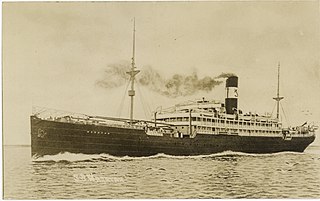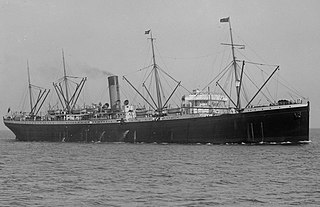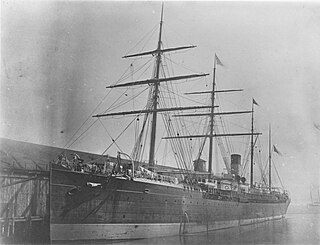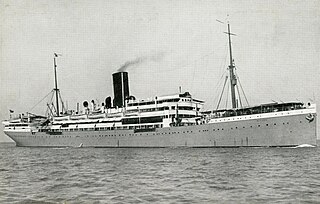
SS Yongala was a passenger steamship that was built in England in 1903 for the Adelaide Steamship Company. She sank in a cyclone off the coast of Queensland in 1911, with the loss of all 122 passengers and crew aboard.

SS Waratah was a passenger and cargo steamship built in 1908 for the Blue Anchor Line to operate between Europe and Australia. In July 1909, on only her second voyage, the ship, en route from Durban to Cape Town along the coast of what is present-day South Africa, disappeared with 211 passengers and crew aboard. No trace of her has ever been found, and her fate remains unknown.

HMAS Bungaree was a cargo steamship. She was built in Scotland in 1937 as Bungaree for the Adelaide Steamship Company of South Australia. The Royal Australian Navy requisitioned her in 1040, and had her converted into a minelayer. She was Australia's only minelayer in the Second World War, and laid more than 10,000 mines. In 1944 she changed rôles, becoming first a survey ship, and then a stores ship. The Navy returned her to her owners in 1947.

SS Medic was a steamship built by Harland and Wolff in Belfast for the White Star Line which entered service in 1899. Medic was one of five Jubilee-class ocean liners built specifically to service the Liverpool–Cape Town–Sydney route. The ship's name pertained to the ancient Persian region of Media and was pronounced Mee-dic.

SS Suevic was a steamship built by Harland and Wolff in Belfast for the White Star Line. Suevic was the fifth and last of the Jubilee-class ocean liners, built specifically to service the Liverpool-Cape Town-Sydney route, along with her sister ship Runic. In 1907 she was wrecked off the south coast of England, but in the largest rescue of its kind, all passengers and crew were saved. The ship herself was deliberately broken in two, and a new bow was attached to the salvaged stern portion. Later serving as a Norwegian whaling factory ship carrying the name Skytteren, she was scuttled off the Swedish coast in 1942 to prevent her capture by ships of Nazi Germany.

Loch Vennachar was an iron-hulled, three-masted clipper ship that was built in Scotland in 1875 and lost with all hands off the coast of South Australia in 1905. She spent her entire career with the Glasgow Shipping Company, trading between Britain and Australia. The company was familiarly called the "Loch Line", as all of its ships were named after Scottish lochs. The ship was named after Loch Venachar, in what was then Perthshire.

SS Abessinia was a cargo steamship of the Hamburg America Line (HAPAG). She was built in North East England in 1900, and wrecked in North East England in 1921. In her early years she sailed from Hamburg to and from China, Australia, and the East Coast of the United States. From 1907 to 1912 she sailed from Hamburg to and from the West Coast of the United States and the British Columbia Coast. In 1913 she survived a storm in the North Atlantic that swept away her rudder and disabled her propulsion. She spent the First World War in Chile. Her remains are now a wreck diving site in the Farne Islands.

Fitzroy was a steel-hulled steamship built in 1912 at Old Kilpatrick, Scotland in 1912. Thirty-one people were killed when Fitzroy capsized in a gale whilst carrying a general cargo between Coffs Harbour and Sydney off Cape Hawke, New South Wales on 26 June 1921.

SS Kwinana was an Australian ocean-going cargo and passenger steamship. She was built in England in 1892 as the cargo ship SS Darius. In 1912 she changed owners, was refitted as a cargo and passenger ship and renamed Kwinana.

SS Arabic was a steamship of the White Star Line and its first steel-hulled vessel. Like her predecessors, she was built by shipbuilders Harland and Wolff of Belfast.

Iserbrook was a general cargo and passenger brig built in 1853 at Hamburg (Germany) for Joh. Ces. Godeffroy & Sohn. It spent over twenty years as an immigrant and general cargo vessel, transporting passengers from Hamburg to South Africa, Australia and Chile, as well as servicing its owner's business in the Pacific. Later on, the vessel came into Australian possession and continued sailing for the Pacific trade. In 1878 it caught fire and was sunk the same year. At last, it was re-floated and used as a transport barge and hulk in Sydney until it sank again and finally was blown up.
John Legoe was a ship's captain, associated with the sailing ships Celestial, The Murray, Yatala and Hesperus, before settling in South Australia, where he and his family were notable citizens.

SS Afric was a steamship built for White Star Line by Harland and Wolff shipyards. She was of the Jubilee class, had a reported gross register tonnage of 11,948, and had a port of registry of Liverpool, England. Afric was launched on November 16, 1898, and was involved in shipping between Liverpool and Australia.

The SS Runic was a steamship built at Harland and Wolff in Belfast for the White Star Line which entered service in 1901. Runic was the fourth of five Jubilee-class ocean liners built for White Star's Australia service along with her sister ship SS Suevic, where she ran on the Liverpool–Cape Town–Sydney route. She served this route until she was requisitioned for use as a war transport between 1915 and 1919, before returning to the Australia service.

The Jubilee class were a group of five passenger and cargo ocean liners built by Harland and Wolff at Belfast, for the White Star Line, specifically for the White Star Line's service from the UK to Australia on the Liverpool–Cape Town–Sydney route. The five ships in order of the dates they entered service were:
Queen Cristina was a steam cargo ship built in 1901 by the Northumberland Shipbuilding Co of Newcastle for Thomas Dunlop & Sons of Glasgow. The ship was designed and built for general cargo trade and spent her career doing tramp trade. She was the second ship named Queen Cristina in service with the Queen Line.

Langton Grange was a refrigerated steam cargo ship built in 1896 by the Workman, Clark & Co. of Belfast for Houlder Brothers & Co. of London to transport meat and other produce from Australia and South America to United Kingdom.
Anglo-African was a steam cargo ship built in 1900 by the Short Brothers of Sunderland for Lawther, Latta & Co. of London with intention of operating on their Australian routes. The vessel operated mostly on South America to North America route during her career and was wrecked on one of her regular voyages in January 1909.
Lalla Rookh was a barque of 372 tons built by Edward Allen in St Helier, Jersey, in "1939", corrected to 1839. Her dimensions were 99.9 × 24.0 × 16.8 ft.

SS Nyassa was a steam ocean liner that was launched in Germany in 1906 as Bülow for Norddeutscher Lloyd (NDL). In 1916 Portugal seized her, renamed her Trás-os-Montes, and placed her under the management of Transportes Marítimos do Estado (TME). In 1924 Companhia Nacional de Navegação (CNN) bought her and renamed her Nyassa. After a long career with CNN she was scrapped in England in 1951.



















